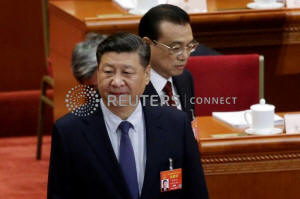|
China to slash taxes, boost lending to
prop up slowing economy
 Send a link to a friend
Send a link to a friend
 [March 05, 2019]
By Kevin Yao and Tom Daly [March 05, 2019]
By Kevin Yao and Tom Daly
BEIJING (Reuters) - China sought to shore
up its slowing economy through billions of dollars in planned tax cuts
and infrastructure spending, with economic growth at its weakest in
almost 30 years due to softer domestic demand and a trade war with the
United States.
The government is targeting economic growth of 6.0 to 6.5 percent in
2019, Premier Li Keqiang said at Tuesday's opening of the annual meeting
of China's parliament, less than the 6.6 percent gross domestic product
growth reported last year.
Sources told Reuters earlier this year that China would cut its 2019
growth target to 6.0 to 6.5 percent from the 2018 target of around 6.5
percent as both global and domestic demand ebbed and the U.S. trade war
heightened economic risks.
Speaking in Beijing's Great Hall of the People, Li warned of the
challenges the world's second-largest economy faced and pledged to keep
it on a safe footing with an array of stimulus measures.
"The environment facing China's development this year is more
complicated and more severe," he said. "There will be more risks and
challenges that are either predictable or unpredictable and we must be
fully prepared for a tough battle."

Li said China's fiscal policy would become "more forceful", with planned
cuts of nearly 2 trillion yuan ($298.3 billion) in taxes and fees for
companies.
Those tax cuts are more aggressive than the 1.3 trillion yuan delivered
in 2018 and include reductions aimed at supporting the manufacturing,
transport and construction sectors.
China's GDP last year expanded at its slowest pace since 1990 due to the
trade war and Beijing's crackdown on financial risks, which raised
corporate borrowing costs and hurt investment.
Analysts say Beijing's move to adopt a GDP target range, rather than a
single growth figure, gives policymakers room to maneuver. But the
increase in planned fiscal stimulus marks an explicit acknowledgement
that authorities remain concerned about growth.
"If you are not sick you will not take so many medicines at one time,"
said Iris Pang, Greater China Economist at ING Wholesale Banking. "It
means the headwinds have not gone away, they are still there."
A longer-term campaign to curb polluting and low-value industries also
slowed China's vast manufacturing sector.
China has ramped up the propaganda in the run-up to parliament, with
state media releasing English-language videos and even a rap song
praising the event as an exercise in Chinese democracy, though the
legislature never rejects laws and its members are chosen for their
loyalty to the Communist Party.
The annual gathering in the capital includes more than 3,000 delegates,
who come from all over China, with ethnic minorities showing up in
colorful traditional outfits.
To support growth, Li said China would closely monitor employment at
exporting companies heavily exposed to the U.S. market and cut the
value-added tax (VAT) for the manufacturing sector to 13 percent from 16
percent. VAT for the transport and construction sectors will be cut to 9
percent from 10 percent.
China aims to create more than 11 million new urban jobs this year and
keep the urban unemployment rate within 4.5 percent, in line with its
2018 goals. At the same time, it will cut the social security fees paid
by companies.
DEEPER TAX CUTS, SUPPORT TO SMES
In a push to ramp up infrastructure investment, China's finance ministry
raised the special bond issuance quota for local governments to 2.15
trillion yuan ($320.8 billion) from 1.35 trillion yuan last year.
[to top of second column]
|

Chinese President Xi Jinping and Chinese Premier Li Keqiang arrive
for the opening session of the National People's Congress (NPC) at
the Great Hall of the People in Beijing, China, March 5, 2019.
REUTERS/Jason Lee

The lower tax revenue and higher government spending push China's
budget deficit target for this year up to 2.8 percent of GDP from
last year's 2.6 percent.
The government has also set a consumer inflation target of around 3
percent despite a recent softening in price rises to less than 2
percent, which gives Beijing some room to stimulate consumption.
Over the past year, China's central bank has cut the reserve
requirements for commercial lenders five times to spur loans to
small and private companies - vital for growth and jobs.
Li said on Tuesday monetary policy would be "neither too tight nor
too loose" and that the government would not resort to a flood of
liquidity. Growth targets for M2 money supply, which includes cash
in circulation and deposits, and total social financing this year
would be in line with nominal GDP growth.
To support private and smaller firms, Li said Beijing will step up
targeted cuts in the reserve requirement ratio for smaller and
medium-sized banks with an aim to boost lending to small companies
by large banks by more than 30 percent.
The government must also continue reforms to hand more power to
market forces, Li said, including steps to reduce red tape so that
companies can "spend more time doing business and less time chasing
approvals."
TRADE RISKS
Addressing one of the biggest challenges China's economy faces, the
government's work report to parliament said it would continue to
promote Sino-U.S. trade negotiations and was committed to
safeguarding economic globalization and free trade.
Li's work report also said China will further improve market access
for foreign investment and create an environment in which Chinese
and foreign firms are "treated as equals and engage in fair
competition."
Separately, China's top banking regulator said on Tuesday Beijing
could "absolutely" reach an agreement with the United States on
opening up its financial sector, even as the country's commerce
minister admitted talks with Washington had been difficult.
In recent weeks, the United States and China appear to have moved
closer to a trade deal that would roll back U.S. tariffs on at least
$200 billion worth of Chinese goods.

U.S. Secretary of State Mike Pompeo said on Monday he thought both
nations were "on the cusp" of a deal to end their trade war.
(Reporting by Kevin Yao, Lusha Zhang, Min Zhang, Stella Qiu, Hallie
Gu, Muyu Xu, Cate Cadell, Xiaochong Zhang, Tom Daly, Yilei Sun, Pei
Li, Norihiko Shirouzu, Se Young Lee, Yawen Chen, Dominique Patton,
Judy Hua, Tony Munroe and Ben Blanchard; Writing by Ryan Woo and
Yawen Chen; Editing by Shri Navaratnam, Sam Holmes and Jacqueline
Wong)
[© 2019 Thomson Reuters. All rights
reserved.]
Copyright 2019 Reuters. All rights reserved. This material may not be published,
broadcast, rewritten or redistributed.
Thompson Reuters is solely responsible for this content. |